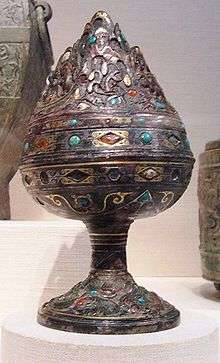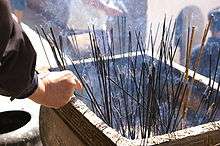Incense in China

Incense in China is traditionally used in a wide range of Chinese cultural activities including, religious ceremonies, ancestor veneration, traditional medicine, and in daily life. Known as xiang (Chinese: 香; pinyin: xiāng; Wade–Giles: hsiang; literally: "fragrance"), incense was used by the Chinese cultures starting from Neolithic times with it coming to greater prominence starting from the Xia, Shang, and Zhou dynasties.[1]
One study shows that during the Han Dynasty (206 BC – AD 220 ) [2] there was increased trade and acquisitions of more fragrant foreign incense materials when local incense materials were considered "poor man's incense".[3]
It reached its height during the Song Dynasty with its nobility enjoying incense as a popular cultural pastime, to the extent of building rooms specifically for the use of incense ceremonies.[1]
Besides meaning "incense", the Chinese word xiang (香) also means "fragrance; scent; aroma; perfume; spice". The sinologist and historian Edward H. Schafer said that in medieval China:
| “ | there was little clear-cut distinction among drugs, spices, perfumes, and incenses – that is, among substances which nourish the body and those which nourish the spirit, those which attract a lover and those which attract a divinity. | ” | |
| — The Golden Peaches of Samarkand, a Study of T'ang Exotics, Edward H. Schafer[4] | |||
Chinese censers
Words meaning "censer; incense burner" are compounds of lu (爐 or 炉) "brazier; stove; furnace", which was a category of ancient Chinese bronzes. Xianglu (香爐, with "incense") means "incense burner; censer" in general. Xunlu (熏爐, with "smoke; fumigate; cure (food) with smoke", or 薰爐, with "fragrance (of plants); an aromatic grass, Eupatorium fortunei") means "small censer, esp. for fumigating or scenting clothing". Shoulu (手爐, with "hand") means "hand-held censer; handwarmer; portable charcoal stove".
The boshanlu (博山爐 "universal mountain censer"), which became popular during the era of Emperor Wu of Han (r. 141 - 87 BC), displayed a microcosmic sacred mountain (esp. Mount Kunlun or Mount Penglai). These elaborate censers were designed with apertures that made rising incense smoke appear like clouds or mist swirling around a mountain peak.[5]
Uses
Medicine
Similar ingredients and processing techniques are involved in production of both incense and Traditional Chinese medicines. For example, take jiu (灸 "moxibustion"). Incense is believed to have physiological and psychological benefits. For instance, according to the Bencao Gangmu pharmacopoeia, "camphor cured evil vapors in heart and belly, and was especially recommended for eye troubles, including cataract."[6]
Time-keeping
Along with the introduction of Buddhism in China came calibrated incense sticks and incense clocks (xiangzhong 香鐘 "incense clock" or xiangyin 香印 "incense seal").[7] The poet Yu Jianwu (庾肩吾, 487-551) first recorded them: "By burning incense we know the o'clock of the night, With graduated candles we confirm the tally of the watches."[8] The use of these incense timekeeping devices spread from Buddhist monasteries into secular society.
Religion

Xiangbang (香棒, with "stick; club") means "incense stick; joss stick". Two "incense" synonyms specifying religious offerings to ancestors or deities are gāoxiāng (高香, "high incense") and gōngxiāng (供香, "offering incense").
The Sunni Muslim Hui Gedimu and the Yihewani burned incense during worship. This was viewed as Daoist or Buddhist influence.[9][10] The Hui, also known as "White-capped HuiHui", used incense during worship, while the Salar, also known as "black-capped HuiHui" considered this to be a heathen ritual and denounced it.[11]
As an art form
The Chinese developed a sophisticated art form with incense burning like with tea and calligraphy called xiangdao (稥道). It involves various paraphernalia and utensils in various ceramic containers utilised to burn incense. Examples include tongs, spatulas, special moulds to create ideograms with incense powder, etc. all placed on a special small table. It is most often used as an enhancement to a personal space to accompany other arts such as tea drinking and guqin playing.
Production
Bamboo processing
Bamboo species with good burning characteristics are harvested and dried. The most common type of bamboo used for producing the sticks is Phyllostachys heterocycla cv. pubescens (茅竹,江南竹) since this species produces thick wood and easily burns to ashes in the incense stick. Other types of bamboos such as Phyllostachys edulis (毛竹) may be used, however due to their fiberous surfaces or relatively thin wood producing good bamboo sticks is more difficult. Longer incense stick are produced using cao bamboo(草竹).[12]
The dried bamboo poles of around 10 cm in diameter are first manually trimmed to length, soak, peeled, and then continuously split in halves until thin sticks of bamboo with square cross sections of less than 3mm width have been produced.[13][14] This process has largely been replaced by machines in modern incense production.
Incense materials
Chinese incense is made from diverse ingredients with much overlap into the traditional Chinese herbal pharmacopoeia. Of all the incense ingredients some of the most commonly used include:
- Chenxiang (沈香, "Agarwood, aloeswood")
- Tanxiang (檀香 "Sandalwood")
- Anxixiang (安息香 "Benzoin resin and wood, gum guggul")
- Cuibai (翠柏 "Calocedrus macrolepis, Chinese incense-cedar")
- Zhangnao (樟腦 "Camphor").
- Ruxiang (乳香, "Frankincense")
- Dingxiang (丁香, "Cloves")
- Bajiao (八角, "Star anise")
- Guipi (桂皮, "Cinnamomum cassia")
- Dahuixiang (大回香, "Foeniculum vulgare")
- Dahuang (大黃, "Rheum officinale")
- Hupo (琥珀, Fossil Amber)
- Gansong (甘松 Spikenard)
- Chuanxiong (川芎 Ligusticum wallichii)
- Wujia (五加 Eleutherococcus senticosus (Acanthopanax senticosus))
- Beijiaxiang (貝甲香 East African marine snails)
The dried powdered bark of Persea nanmu(楠木皮) is used extensively for its mucilaginous qualities, which helps to bind the other powdered ingredients together.
Processes
Incense powder is formed into the final product through various methods.[12]
Lin-xiang
Incense powder is tossed over wet sticks
Nuo-xiang
Incense paste is kneaded around sticks.
Sculpting
For large incense pillars, incense paste is piled around a single bamboo stick and sculpted to shape
Winding
Incense paste is extruded and wound to produce spiral incense
See also
References
- 1 2 劉良佑,《香學會典》,臺北:東方香學研究會,2003
- ↑ Needham, Joseph and Lu Gwei-Djen (1974). Science and Civilisation in China: Volume 5, Chemistry and Chemical Technology; Part 2, Spagyrical Discovery and Invention: Magisteries of Gold and Immortality. Cambridge University Press. p. 132.
- ↑ Schafer, Edward H. (1963). The Golden Peaches of Samarkand, a Study of T'ang Exotics. University of California Press.
- ↑ Schafer, Edward H. (1963). The Golden Peaches of Samarkand, a Study of T'ang Exotics. University of California Press. p. 155.
- ↑ Erickson, Susan N. (1992). "Boshanlu: Mountain Censers of the Western Han Period: A Typological and Iconological Analysis", Archives of Asian Art 45:6-28.
- ↑ Schafer (1963), p. 167.
- ↑ Bedini, Silvio A. (1963). "The Scent of Time. A Study of the Use of Fire and Incense for Time Measurement in Oriental Countries". Transactions of the American Philosophical Society. Philadelphia, Pennsylvania: American Philosophical Society. 53 (5). doi:10.2307/1005923. JSTOR 1005923.
- ↑ Tr. Schafer (1963), p. 160.
- ↑ BARRY RUBIN (2000). Guide to Islamist Movements. M.E. Sharpe. p. 80. ISBN 0-7656-1747-1. Retrieved 2010-06-28.
- ↑ Michael Dillon (1999). China's Muslim Hui community: migration, settlement and sects. Richmond: Curzon Press. p. 77. ISBN 0-7007-1026-4. Retrieved 2010-06-28.
- ↑ Knights of Columbus. Catholic Truth Committee (1913). The Catholic encyclopedia: an international work of reference on the constitution, doctrine, discipline, and history of the Catholic Church, Volume 3. Encyclopedia Press,. p. 680. Retrieved 2011-01-23.
- 1 2 Chen(陳), Ka-Yan(家恩), Joss Stick Manufacturing: A Study of a Traditional Industry in Hong Kong (PDF), sunzi1.lib.hku.hk
- ↑ 陳, 永順 (2010-03-07), "失落百年 「剖香腳」技藝重現", 聯合報, 聯合新聞網
- ↑ 葉, 月珠, 香腳
External links
| Chinese Wikisource has original text related to this article: |
- Fragrant Pouches, Global Chinese Language and Culture Center Online Folklore
- Frangant Pouches in Taiwan
- Divine Fragrances, Taiwan Review, 06/01-2008, Oscar Chung
- 中国香文化网, Chinese Incense Culture Website (Chinese)
- 中国人为何要烧香?, China Central Television (Chinese)
- 中華東方香學研究會 Chinese Incense Art Association, A government-certified non-profit organization promoting the study and practice of incense arts (Chinese)